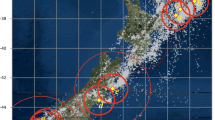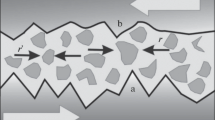Abstract
Analysis of aftershock sequences of the strongest earthquakes of the world showed that previously discovered empirical relations are not universal. Båth’s law is found to be invalid in the majority of cases, while Omori’s law is valid only in a short initial interval of aftershock activity. It is supposed that aftershocks of the strongest earthquakes of normal depths are related initially to fracture of zones that preserved their integrity after the rupture in the source of the main shock and at a later stage to relaxation of stresses in the medium adjacent to the rupture.
Similar content being viewed by others
References
S. S. Arefiev and R. E. Tatevossian, “Structure and Seismic Regime of the Source Zone of the Spitak Earthquake,” Izv. Akad. Nauk SSSR, Fiz. Zemli, No. 11, 74–85 (1991).
S. S. Arefiev, K. G. Pletnev, R. E. Tatevossian, et al., “The Racha Earthquake of 1991: Results of In Situ Seismological Observations,” Fiz. Zemli, No. 3, 12–23 (1993).
M. Båth, “Lateral Inhomogeneities of the Upper Mantle,” Tectonophysics, 2(6), 483–514 (1965).
Y. Ben-Zion and V. Lyakhovsky, “Analysis of Aftershocks in a Lithospheric Model with Seismogenic Zone Governed by Damage Rheology,” Geophys. J. Int., 165, 197–210 (2006).
CMT Catalog (http://www.seismology.harvard.edu).
S. Das and C. H. Scholz, “Theory of Time-Dependent Rupture in the Earth,” J. Geophys. Res. 86, 6039–6051 (1981).
A. M. Dziewonski and J. H. Woodhouse, “An Experiment in Systematic Study of Global Seismicity: Centroid-Moment Tensor Solutions for 201 Moderate and Large Earthquakes of 1981,” J. Geophys. Res. 88(B4), 3247–3271 (1983).
V. G. Gitis, R. E. Tatevossian, and A. P. Vainshtock, “Maximum Expected Magnitude Assessment in a Geo Computer Environment,” Natural Hazards 17, 225–250 (2000).
S. J. Gross and C. Kisslinger, “Tests of Models of Aftershock Rate Decay,” Bull. Seismol. Soc. Am. 84, 1571–1579 (1994).
T. Hirabayashi, K. Ito, and T. Yoshii, “Multifractal Analysis of Earthquakes,” Pure Appl. Geophys, 138, 591–610 (1992).
International Seismological Centre, On-Line Bulletin (Int. Seismol. Centre, Thatcham, 2001) (http://www.isc.ac.uk).
C. Kisslinger and L. M. Jones, “Properties of Aftershock Sequences in Southern California,” J. Geophys. Res. 96, 11 947–11 958 (1991).
B. V. Kostrov and Sh. Das, Principles of Earthquake Source Mechanics (Univ. Press, Cambridge, 1988).
K. I. Kuznetsova, “Seismicity as a Stochastic Process with Physical Parameters,” Izv. Akad. Nauk SSSR, Fiz. Zemli, No. 12, 16–28 (1983).
K. I. Kuznetsova, Zh. Ya. Aptekman, N. V. Shebalin, and V. V. Shteinberg, “Aftershocks of Aftereffect and Aftershocks of Development of the Source Zone of the Daghestan Earthquake,” in Physics of Earthquakes (Nauka, Moscow, 1976), pp. 94–113 [in Russian].
W. Marzocchi and L. Sandri, “A Review and New Insights on the Estimation of the b-Value and Its Uncertainty,” Ann. Geophys. 46(6), 1271–1282 (2003).
N. Mizaei, M.-T. Gao, Y.-T. Chen, and J. Wang, “A Uniform Catalog of Earthquakes for Seismic Hazard Assessment in Iran,” Acta Seismologica Sinica, 10(6), 713–726 (1997).
G. M. Molchan and O. E. Dmitrieva, “Identification of Aftershocks: A Review and New Approaches,” in Computational Seismology, Vol. 24, 19–50 (1991).
C. Narteau, P. Shebalin, and M. Holschneider, “Temporal Limits of the Power Law Aftershock Decay Rate,” J. Geophys. Res. 107 (2002).
A. Nur and J. R. Booker, “Aftershocks Caused by Pore Fluid Flow,” Science 175, 885–887 (1972).
F. Omori, “On the Aftershocks,” Rep. Imp. Earthquake Invest. Comm. 2, 103–139 (1894).
G. Ouillon and D. Sornette, “Magnitude-Dependent Omori Law: Theory and Empirical Study,” J. Geophys. Res., 110 (2005).
V. A. Petrov, “On the Recurrence Law of Earthquakes,” Izv. Akad. Nauk SSSR, Fiz. Zemli, No. 8, 92–93 (1981).
A. G. Prozorov, “Remote Aftershocks as Precursors of Earthquakes in Southern California,” Computational Seismology, Vol. 14, 20–26 (1982).
Yu. V. Riznichenko, “On the Treatment of the Earthquake Recurrence Law in Terms of Energy,” Izv. Akad. Nauk SSSR, Fiz. Zemli, No. 10, 7–16 (1965).
R. Shcherbakov and D. L. Turcotte, “A Modified Form of Båth’s Law,” Bull. Seismol. Soc. Am. 94, 1968–1975 (2004).
R. Shcherbakov, D. L. Turcotte, and J. B. Rundle, “Scaling Properties of the Parkfield Aftershock Sequence,” Bull. Seismol. Soc. Am. 96(4), 376–384 (2006).
V. B. Smirnov and A. V. Ponomarev, “Seismic Regime Relaxation Properties from In Situ and Laboratory Data,” Fiz. Zemli, No. 10, 26–36 (2004) [Izvestiya, Phys. Solid Earth 42 (10), 807–816 (2004)].
R. E. Tatevossian, E. A. Rogozhin, and S. S. Arefiev, “Earthquake Intensity Estimation from Seismic Effects in the Natural Environment: General Principles and Examples of Application,” in Problems of Engineering Seismology (2007).
S. D. Vinogradov, “Aftershock Sequences as Evidence for Relaxation Processes in a Region Containing an Earthquake Source,” Fiz. Zemli, No. 2, 59–62 (2008) [Izvestiya, Phys. Solid Earth 44 (2), 138–141 (2008)].
S. Weimer and K. Katsumata, “Spatial Variability of Seismicity Parameters in Aftershock Zones,” J. Geophys. Res. 104, 13135–13151 (1999).
D. Wells and K. J. Coppersmith, “New Empirical Relationships among Magnitude, Rupture Length, Rupture Width, Rupture Area, and Surface Displacement,” Bull. Seismol. Soc. Am. 84(4), 974–1002 (1994).
P. Wessel and W. Smith, “The Generic Mapping Tools,” GMT 4, 1 (2007).
G. Zöller, S. Hainzl, M. Holschneider, and Y. Ben-Zion, “Aftershocks Resulting from Creeping Sections in a Heterogeneous Fault,” Geophys. Res. Lett. 32 (2005).
Author information
Authors and Affiliations
Corresponding author
Additional information
Original Russian Text © R.E. Tatevossian, Zh.Ya. Aptekman, 2008, published in Fizika Zemli, 2008, No. 12, pp. 3–23.
Rights and permissions
About this article
Cite this article
Tatevossian, R.E., Aptekman, Z.Y. Aftershock sequences of the strongest earthquakes of the world: Stages of development. Izv., Phys. Solid Earth 44, 945–964 (2008). https://doi.org/10.1134/S106935130812001X
Received:
Published:
Issue Date:
DOI: https://doi.org/10.1134/S106935130812001X




